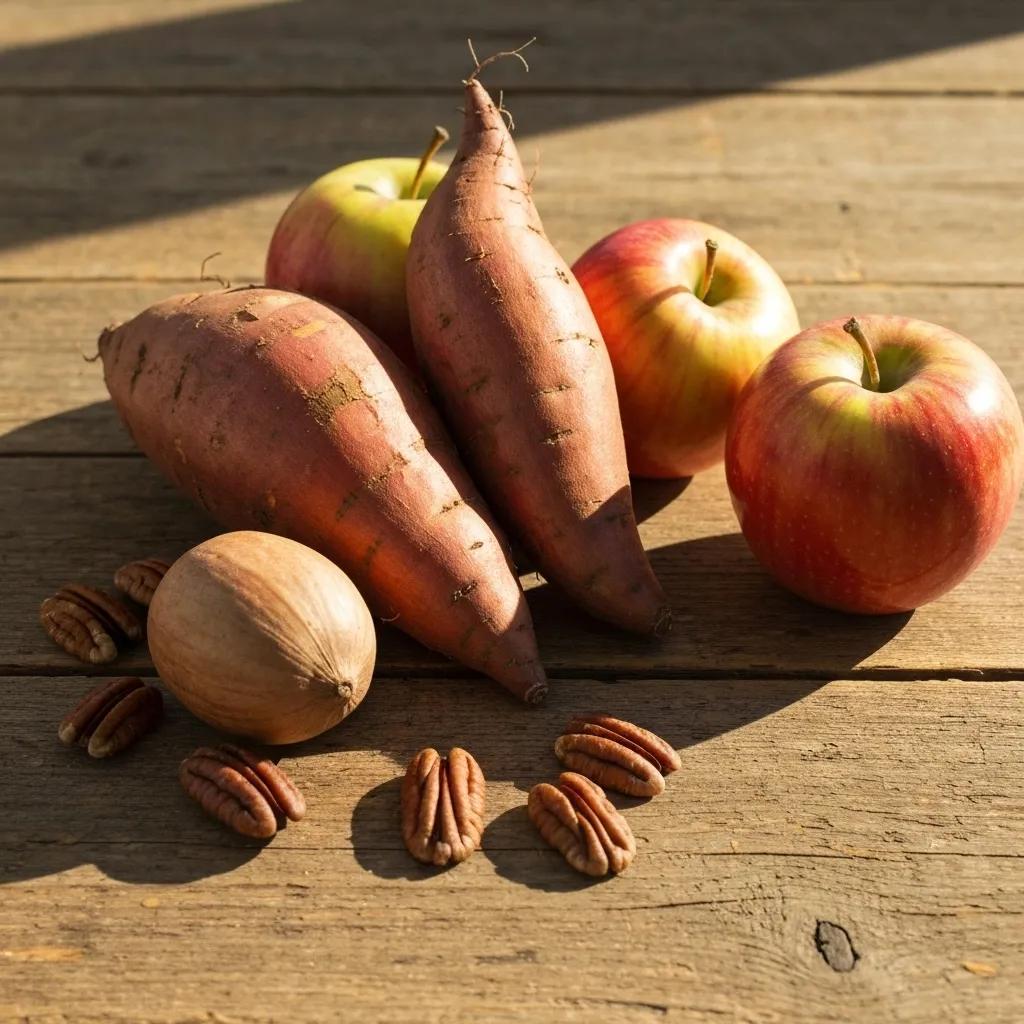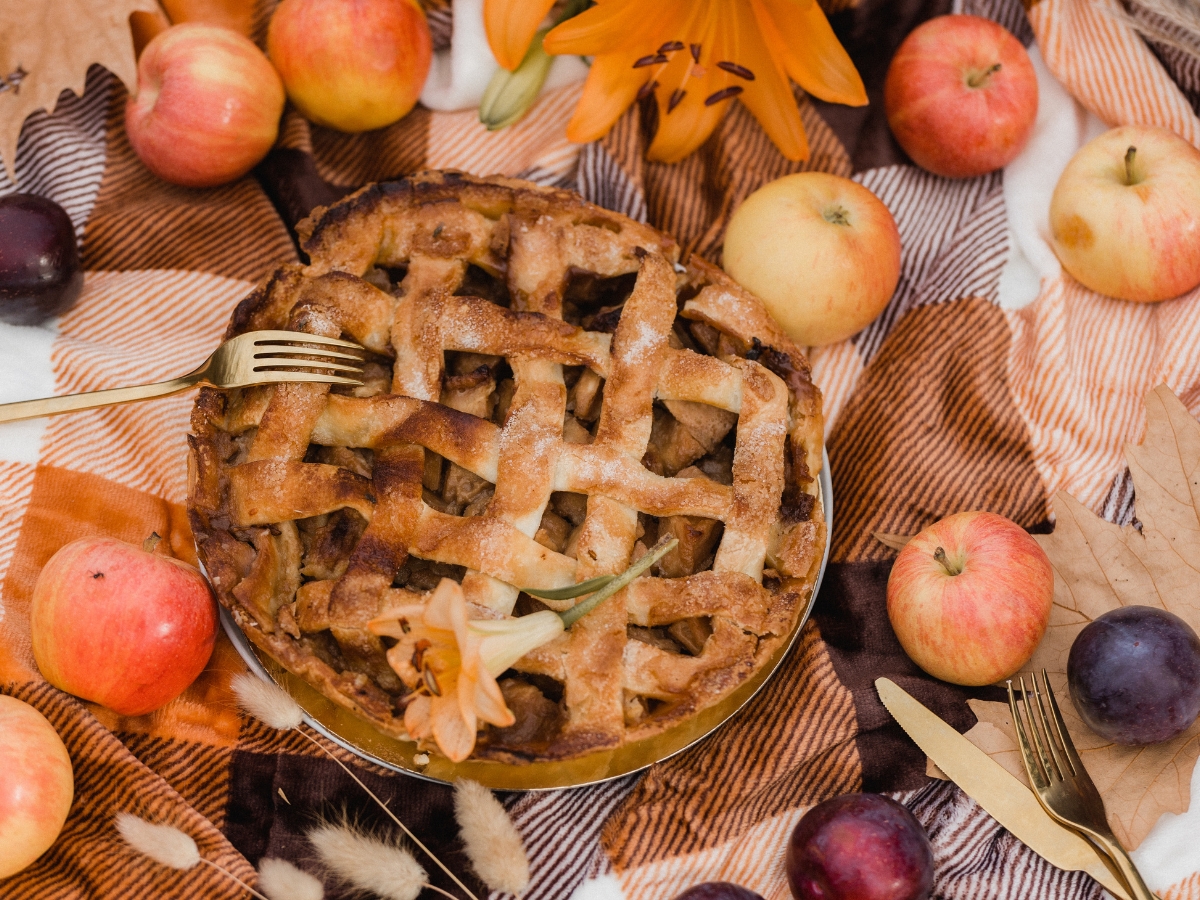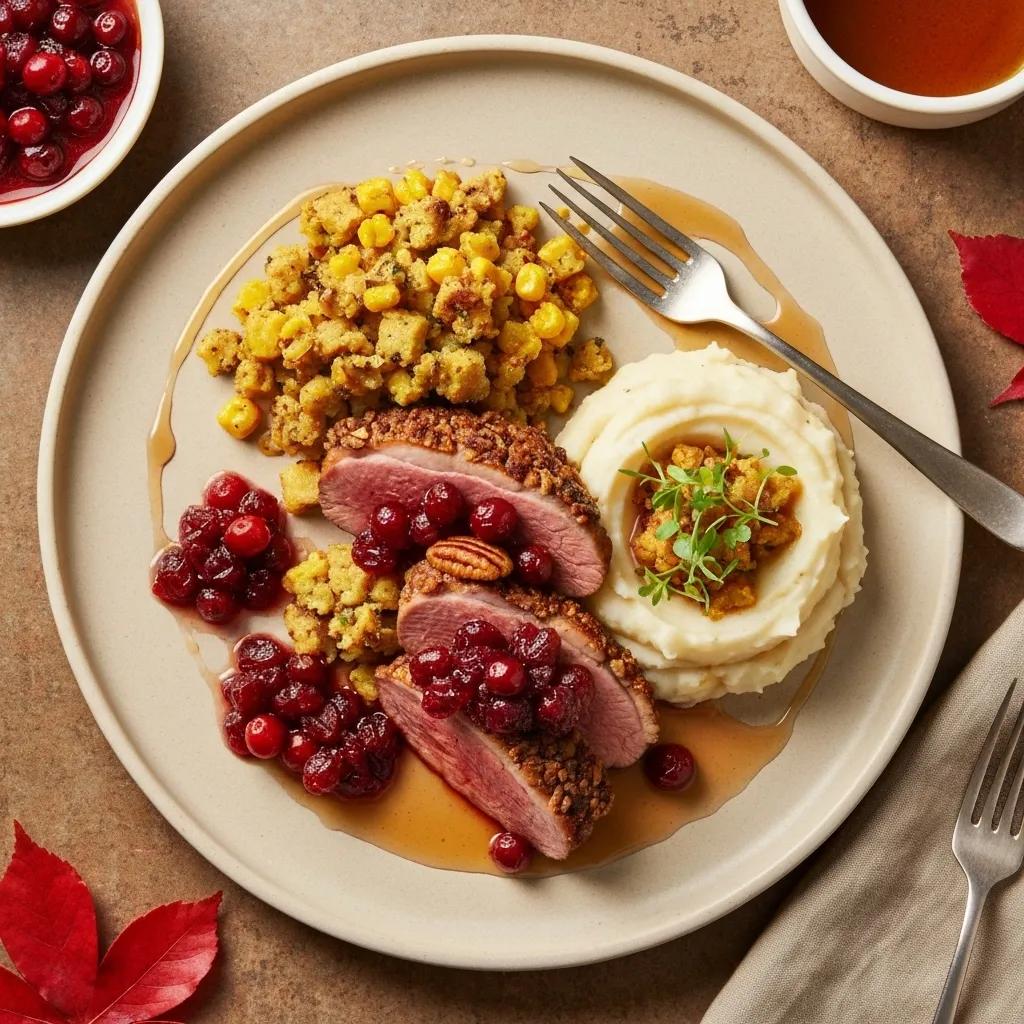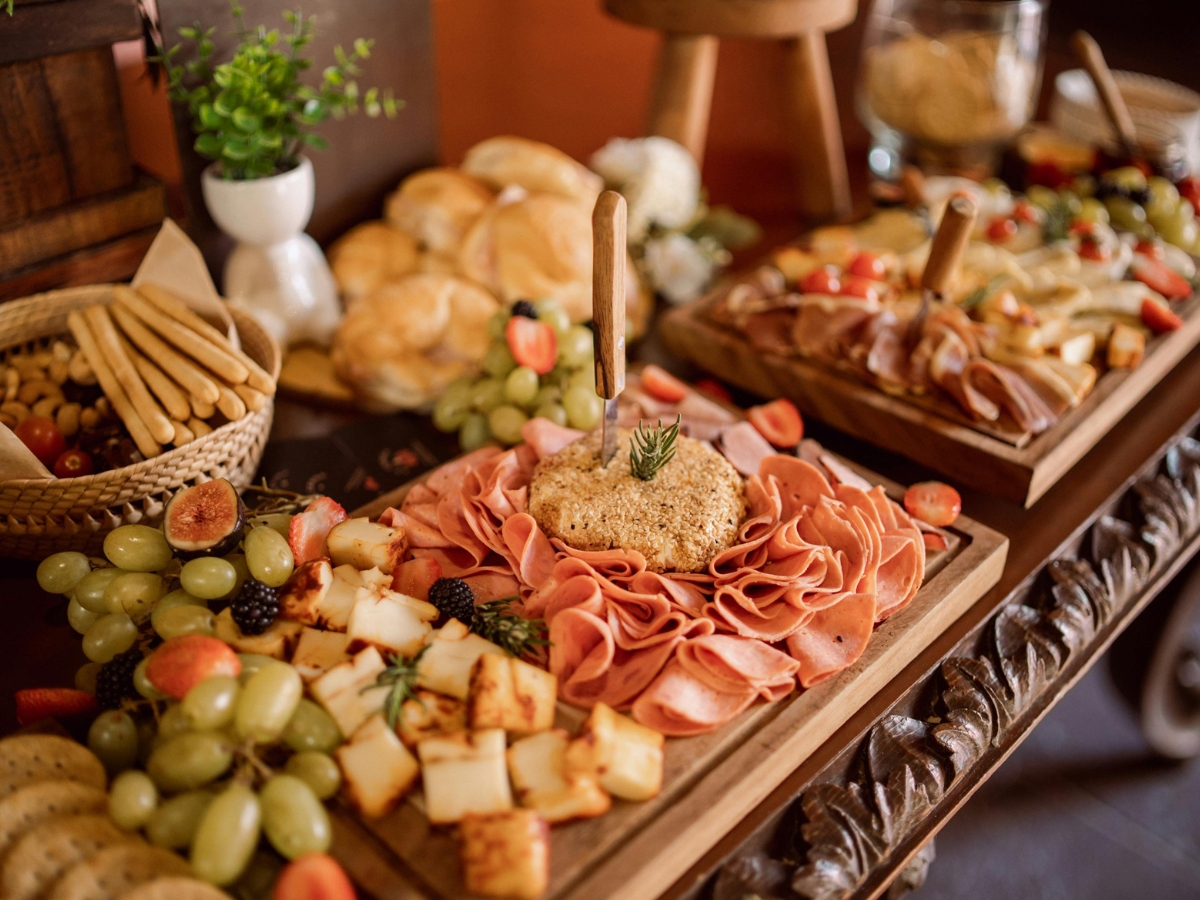As the heat of a Georgia summer gives way to the crisp air of autumn, the state’s rich culinary heritage offers a perfect palette for creating a fall catering menu that feels both nostalgic and novel. Incorporating local flavors—from sweet Vidalia onions and pecans to muscadine grapes and pasture-raised pork—not only supports Georgia farmers but also gives your dishes an authentic sense of place that guests can taste. In this guide, we’ll explore how to creatively weave these regional ingredients into seasonal offerings, whether you’re crafting hearty comfort food for a wedding reception or elegant, Georgia-inspired appetizers for a corporate event, ensuring your fall catering menu is memorable, meaningful, and distinctly local.
Celebrate Autumn with a Fall Catering Menu Full of Flavor
What Are the Must-Have Georgia Flavors for Your Fall Catering Menu?

Georgia’s autumn harvest is a built-in roadmap for planning an unforgettable fall catering menu. When you lead with local staples at their peak, you get better texture, fuller flavor, and a menu that feels rooted in place. Think pecans with real depth, crisp apples, earthy sweet potatoes, sturdy collard greens, and the dark sweetness of sorghum syrup. These ingredients are easy to mix and match across starters, mains, and desserts, so your menu stays cohesive without feeling repetitive.
Top Seasonal Catering Menu Ideas for Georgia Events
Pecans come into their own in October and November and add buttery crunch to both savory and sweet dishes. Use them to crust chicken or trout, fold into brown-butter dressing for salad, or finish a skillet cornbread. Apples are best in September and October and bring clean acidity that cuts through richer plates. Try apple-cider gastrique over pork, diced apples in a shaved-collard salad, or warm spiced compote over pound cake. Sweet potatoes run from early fall through December and give you natural creaminess for gratins, whipped purées, and hand pies. Collard greens hit their stride as nights cool, holding up well in slow braises or quick sautés with garlic and vinegar. Together, these four anchors give you balance: crunch, brightness, comfort, and backbone.
How Do Traditional Georgia Spices Elevate Fall Dishes?
Sorghum syrup behaves like a softer molasses and shines when roasted onto root vegetables or brushed over grilled meats near the end of cooking. Cayenne and paprika bring gentle heat and color, especially on pecan-crusted proteins or smoky rubs for pork shoulder. Cinnamon and clove pair naturally with apples and can also lift savory dishes when used with restraint, like a light dusting in a pan sauce or vinaigrette. The goal is warmth, not heaviness. Layer these seasonings so the first bite is inviting and the last bite doesn’t feel tired.
What Local Produce is Ideal for Autumn Event Catering in Atlanta?
Heirloom pumpkins make silken soups and fillings for ravioli, and they purée into dips that hold well for service. Muscadine grapes bring a distinctly regional note; cook them down into a chutney for cheese boards or reduce their juice into a bright glaze for poultry. Butternut squash is versatile enough for velvety sides and pasta sauces without weighing down the plate. North Georgia mushrooms add savor to tarts, risotto, or simple sautéed toppings for steak. When possible, source from area farms and markets so you can build a menu that reads local on the page and tastes local on the plate.
Sample Dish Ideas to Pull it Together
Open with a shaved-collard and apple salad with toasted pecans and a sorghum-cider vinaigrette. Follow with pecan-crusted chicken or trout, a sweet potato gratin with thyme, and garlicky braised greens finished with apple cider vinegar. For a vegetarian main, serve pumpkin ravioli with brown butter and fried sage, plus roasted mushrooms as a topper. Close with warm apple crumble or a thin pecan tart and lightly sweet whipped cream.
When you let Georgia’s peak produce lead the way, your fall catering menu feels seasonal, honest, and memorable from the first bite to the last.
Designing A Georgia Fall Catering Menu That Captivates Atlanta Clients

A standout fall catering menu starts with Georgia’s harvest and builds from there. When you pair regional ingredients with familiar formats, guests feel at home and still get something memorable. Aim for layered textures, warm colors, and flavors that balance comfort with brightness. That mix keeps the menu cohesive across courses and works for everything from corporate gatherings to backyard celebrations.
Popular Georgia-Inspired Fall Dishes
Begin with dishes that showcase local staples at their peak. Pecan-crusted chicken finished with a light sorghum glaze gives you crunch, gentle sweetness, and a clean finish. Applewood smoked pork loin with apple-onion chutney ties smoke to acidity, so richer bites never feel heavy. Sweet potato and cheddar grits served in small ramekins bring creamy depth that holds well on a buffet or plated service. For a fresh counterpoint, a grilled peach and burrata salad with honey vinaigrette delivers soft, charred, and cool in one bite. To close, bourbon-poached pear with a pecan crumble bar offers an easy slice-and-serve dessert that reads seasonal without being fussy.
Balancing Classics And Fresh Ideas
Guests in Atlanta love tradition, but they also notice when a menu shows a bit of imagination. Keep the heart of a classic, then update the form. Turn mashed sweet potatoes into a silky mousse piped into crisp phyllo shells. Add a spoonful of collard green pistou to brighten roasted chicken. Reduce muscadine juice to a glossy glaze for pork or turkey. Run small tests at tastings before rolling out a new item, note how it holds over time, and adjust seasoning for service at scale. Rotating chef specials that feature lesser-known produce, like North Georgia mushrooms or heirloom pumpkins, keep repeat clients interested while staying true to the season.
Crowd Favorites For Atlanta Events
Events move better when there are easy bites that travel well from tray to table. Mini buttermilk biscuits with smoked turkey and garlicky collards are steady winners since they pack classic flavor into a few neat bites. Peach barbecue meatballs on skewers hit the sweet-savory note guests expect in fall, and they hold their temperature without drying out. A small bowl of praline pecans at each table keeps conversations going between courses. Sweet potato hushpuppies paired with a maple-cayenne dip bring crisp edges and a soft center, which plays well with cocktails and beer. These items are simple to replenish and keep lines short, so the flow of the event stays smooth.
Bringing It All Together
The best results come from a plan that links courses by ingredient and tone. Use apples or peaches in more than one place, but change the treatment so flavors feel new each time. Balance rich plates with vinegar, citrus, or fresh herbs. Write menus in clear language that highlight Georgia sources without overpromising. When your fall catering menu blends regional identity with crowd-pleasing formats, you deliver a meal that suits many tastes and still feels distinctly local. Guests leave satisfied, and the event feels like a true snapshot of autumn in Georgia.
Why Should You Choose Local Fall Flavors for Your Autumn Event Catering in Atlanta?

Building a fall catering menu around Georgia-grown ingredients gives you better flavor, steadier quality, and a menu that actually feels like autumn in Atlanta. Shorter travel times mean produce is picked closer to peak, so textures hold up on the plate, and seasoning can stay simple. You also support nearby farms and makers, which matters to clients who care where their food comes from.
How Local Ingredients Improve Freshness And Taste
A short supply chain protects taste and texture. Apples gathered in season keep their snap in salads and slaws instead of turning soft. Squash roasted the day it arrives purées into a smooth base for soups without extra cream. Collards and other hearty greens stay bright and sturdy after a quick sauté, so they do not wilt on a buffet. When fruit is ripe, you can lean on natural sweetness rather than heavy sugar, and when vegetables are crisp, you can season with salt, acid, and herbs instead of masking blandness. The result is food that tastes clean and travels well from kitchen to table.
Sustainability Benefits Of Sourcing Georgia Produce
Buying from local farms lowers the distance each ingredient travels, which cuts fuel use and packaging. Fewer handoffs reduce the need for extra plastic or bulk ice to keep items stable, and tighter delivery routes mean less waste from spoilage. Working with growers across the region encourages crop variety, so you are not relying on one or two sources for key items. That diversity makes pricing and availability more predictable through the season. Money spent with family farms also stays in the community, which strengthens the local supply chain you depend on for future events.
How Local Flavors Elevate The Guest Experience
Regional ingredients create a story guests can taste. A pecan crumble topping on roasted sweet potatoes, an apple and collard salad with sorghum vinaigrette, or grilled peaches paired with soft cheese signals Georgia without a long menu note. People notice when dishes connect to the time and place of the event. They also remember simple, well-balanced plates that do not feel heavy. Using apples, pecans, squash, and greens in more than one course ties the meal together, but changing the technique keeps each course fresh. Think roasted then puréed squash for a first course, and thin shaved squash ribbons with citrus for the next.
Putting Local Into Practice
Start by selecting two or three anchor ingredients that will appear across courses in different forms. For example, build a first course around shaved collards with apple, toasted pecans, and a cider dressing. Follow with pecan-crusted chicken finished with a light sorghum glaze, plus roasted sweet potatoes and garlicky greens. Offer a vegetarian main like pumpkin ravioli with brown butter and herb breadcrumbs, then finish with warm apple crumble or a thin pecan tart and lightly sweet whipped cream. Keep the seasoning focused on salt, acid, and gentle heat so the produce leads.
When you plan your fall catering menu with Georgia-grown staples, you get better flavor, less waste, and a clear sense of place. It is a practical way to meet client expectations while serving food that feels right for the season and the city.
How to Source Authentic Georgia Ingredients for Your Seasonal Catering Menu?

A great fall catering menu starts long before the cooking. It begins with the growers, markets, and co-ops that shape what reaches your kitchen. When you build real relationships, visit fields, and plan around harvest cycles, you get consistent quality and a menu that tastes like Georgia in autumn.
Where To Find Georgia’s Fall Produce
Atlanta has a strong network of growers and markets that reward a little legwork. Buford Highway Farmers Market is a dependable stop for broad selection and quick fills when you need variety. For tree fruit, Mercier Orchards in Blue Ridge is known for apples and late peaches when the weather cooperates. Winter squash travels well from Square Roots Farm in Newnan, giving you reliable flesh for roasting, purées, and soups. The Atlanta Botanical Garden’s harvest programming can connect you with unique, small-batch items that add character to specials. Treat these sources as partners. Learn how they pack, when they pick, and what they expect during peak weeks so your prep team can plan with confidence.
Best Practices For Partnering With Georgia Suppliers
Start with clear standards. Define ripeness, size, and pack types in writing so everyone knows what success looks like. Share sample specs with photos and a simple acceptance checklist. Set delivery windows that match your production schedule and build in a short buffer for traffic or weather. Before you commit to volume, run a small trial order and track yield after trimming so you can price portions accurately. Farm visits help you confirm irrigation, soil health, and handling. They also build trust, which pays off when you need a quick substitution or a late pickup during a busy week. Stay in regular contact as the season shifts so your orders match what the fields can actually support.
How To Keep Quality And Seasonality Front And Center
Make tasting a standard step for every new arrival. A quick trim, roast, and salt test tells you if squash is sweet enough to stand on its own or if it needs support from cider or sorghum. Hold a short lineup meeting with cooks to agree on the week’s seasoning targets, then note any changes on the prep sheet. Keep a short list of backup farms for high-demand items like apples and collards so you do not rewrite the menu when a storm hits. Rotate dishes as the season moves. Open with early apples and tender greens, then shift toward heartier squash, mushrooms, and pecans as nights cool. Plan one or two contingency dishes that accept swaps without changing the guest experience, such as a salad that can feature shaved collards one week and thin ribbons of squash the next.
Bringing It All Together For Events
Link your sourcing plan to your menu language so guests feel the connection without a long explanation. Name the orchard or farm in a quiet line under a dish, and let the food carry the story. When your team buys at peak and cooks with restraint, the results are clear flavors, steady costs, and fewer last-minute changes. Most of all, your fall catering menu will read local, taste fresh, and hold up from the first tray pass to the last plate.
What Are Creative Ways to Incorporate Georgia Fall Flavors into Catering Dishes?

A strong fall catering menu starts with Georgia’s harvest and then plays with form. Keep the soul of Southern cooking, but borrow smart techniques from elsewhere to make flavors pop without feeling heavy. Think bright acids to balance richness, crisp textures against creamy bases, and herbs that lift slow-cooked notes. When you rework familiar ingredients in surprising ways, guests lean in and keep tasting.
Using Pecans, Apples, And Sweet Potatoes In New Ways
Pecans do more than crust a cutlet. Pulse toasted nuts with parsley, lemon, and olive oil to make a pecan pesto that spreads easily on crostini or finishes roasted vegetables. Fold a spoon into warm grains for depth without extra dairy. Apples bring clean acidity that cuts through richer plates. Reduce fresh cider and whisk it into a vinaigrette for shaved collards and fennel, or glaze small meatballs so they read sweet-tart rather than sugary. Sweet potatoes can go airy instead of dense. Roast until caramelized, then whip with a splash of buttermilk for a mousse layered in glasses and topped with candied pecans. The same purée anchors savory dishes when blended with vegetable stock and finished with a cider swirl.
Signature Georgia-Inspired Appetizers And Desserts
Open with two-bite crostini brushed with pecan pesto and a sliver of apple for crunch. Follow with apple cider glazed meatballs that hold well on trays and stay tender as the night goes on. For a plated dessert that is easy to portion, build sweet potato mousse parfaits with spiced crumb between layers so each spoon hits creamy and crisp. A warm bourbon-peach mini cobbler delivers a classic note in a compact format and pairs naturally with coffee or a soft pour of dessert wine. These pieces showcase local staples while moving smoothly from reception to seated courses.
Modern Takes On Southern Classics
Update tradition without losing comfort. Turn biscuits into slider buns and tuck in smoked turkey with garlicky collards for a neat handheld that still tastes like Sunday lunch. Swap heavy fats for lighter oils where it makes sense, like using avocado oil in a nutty pie crust that stays flaky. Deconstruct long-simmered greens into a bright salad: thin ribbons of collards tossed with cider vinegar, sorghum, and crushed pecans. For a richer main, lacquer pork with a muscadine reduction instead of a sugary barbecue sauce. The idea is to keep the profiles guests love while improving balance, texture, and serviceability.
Pairing And Presentation That Make Flavors Land
A small touch can make a dish feel complete. Finish pecan-crusted chicken with a light brush of warm sorghum right before it leaves the pass so the glaze stays glossy. Add shaved raw apple to a collard salad for snap at the last second. Use herb oil drizzles and toasted nut dust to tie plates together visually across courses. Keep portions modest and let acidity reset the palate between bites so guests can enjoy the full range of the meal.
Bringing It All Together
Plan the menu around a few anchors like pecans, apples, peaches, and sweet potatoes, then vary the technique from course to course. By blending Southern staples with clean, modern touches, your fall catering menu will taste local, look polished, and move smoothly from first tray pass to final dessert.
How to Market Your Georgia Fall Catering Menu to Atlanta Event Planners?

A strong plan starts with a clear message. Lead with what makes your food distinct in this season: Georgia produce at its peak, balanced flavors, and menus that work for real events, not just photo shoots. Tie every claim to something concrete, like where you source apples or how you handle service timing for outdoor receptions. When planners see specifics, they trust you faster.
Clarify Your Message
Write a short positioning line you can repeat on your site, social posts, and proposals. For example, “Atlanta catering built around Georgia’s fall harvest, designed for smooth service and clean, memorable flavors.” Keep your copy tight, avoid filler, and make sure the photos show the same dishes clients will actually receive. Use captions that name the farm, the ingredient, and the event type so each image does marketing work.
Use The Right Keywords
Make it easy to find you when planners search. Fit phrases like “fall catering menu,” “Georgia seasonal catering,” “Atlanta autumn catering,” and “local Georgia flavors” into page titles, H1s, and the first 100 words of your landing pages. Work them into natural sentences in menu descriptions and case studies rather than stuffing them in a list. Add one short blog each week that answers a real question planners ask, such as sample timelines or portion planning for cocktail-style receptions.
Showcase Local Flavor
Turn sourcing into a story. Share short videos of a farm pickup, a crate of pecans arriving, or a quick tasting with your team. Post an ingredient spotlight that explains why a certain apple or squash variety tastes better in October and how you use it in two different dishes. A simple behind-the-scenes reel paired with a caption about freshness says more than a generic promise about quality.
Choose Channels That Reach Planners
Focus where your buyers are. Instagram and TikTok help you show movement and texture, but your website and email list close the gap to booking. Send a brief monthly update with a seasonal menu, two photos from recent events, and a link to a sample proposal. Tag venues and planners you worked with, and write a one-sentence takeaway about what went well, such as a quick kitchen setup that kept lines short.
Lean Into Trends That Fit The Season
Present trends as solutions, not gimmicks. Interactive stations work when they solve a traffic or timing problem. A build-your-own sweet potato bowl station keeps guests moving and gives dietary flexibility without slowing service. Small-batch bourbon pairings make sense with pecan desserts or apple tarts when the venue allows alcohol service. Grazing tables can be more than charcuterie if you anchor them with Georgia produce and warm elements that hold temperature. Plant-forward plates should feel abundant, with roasted vegetables, grains, and bright sauces that stand on their own.
Turn Tastings Into Bookings
Host compact tastings built around three courses that highlight local ingredients. Keep the flow tight, show your service ware, and hand over a one-page proposal with pricing ranges, date holds, and an easy next step. Ask for quick feedback on flavor, portion size, and presentation, then adjust copy and photos on your site to match what clients responded to.
Track What Works And Iterate
Measure which posts bring inquiries, which emails get replies, and which dishes convert tastings into signed events. Trim anything that does not move results and put more energy where planners actually respond. With a focused message, proof of local sourcing, and steady optimization, your fall catering menu will stand out in Atlanta’s busy season.
What Are Common Challenges When Incorporating Local Georgia Flavors in Fall Catering?

Bringing Georgia-grown ingredients to the table elevates flavor and gives events a clear sense of place. It also introduces moving parts that require planning. Seasonal swings, price shifts, and the need for consistent technique can strain a kitchen if you are not ready. Addressing those realities up front keeps your fall catering menu steady across busy weeks.
How To Manage Seasonal Availability And Maintain Menu Flexibility
Start with a core menu that rarely changes, then add a rotating market section that follows what growers have in peak supply. Write each dish with at least one smart substitution so you can swap varieties without changing the guest experience. For example, trade shaved collards for thin ribbons of squash when a cold snap slows greens. Share a brief availability note with clients during planning so they understand that small adjustments protect quality. Confirm supply with farms twice a week in peak season and lock in picks for key items the day before production. This rhythm gives you fresh product and enough time to adjust prep lists.
Cost Considerations For Local Sourcing
Premium produce can cost more during peak demand. Build a cushion of 10 to 15 percent into food costs for market items and keep a short list of alternate suppliers for apples, greens, and squash. Early-season bulk buys on shelf-stable items like sorghum and pecans can lower your average cost over the month. Track yields after trimming, so portion costs are based on what actually reaches the plate, not just the price per pound. When prices spike, shift value into technique and presentation rather than adding costly components. A simple example is roasting squash longer for deeper flavor instead of leaning on additional dairy.
Training Staff To Execute Authentic Georgia Fall Dishes
Consistency comes from shared standards, not guesswork. Run short, hands-on sessions that cover ingredient ID, ripeness cues, basic prep, and plating. Taste each new arrival together and note the target seasoning on a prep sheet so cooks have a clear aim. Provide concise recipe cards with weights, temperatures, and hold times that match your service style. A quick script helps servers explain an orchard name or a grower partnership in one sentence without slowing the floor. When staff can describe why a dish tastes the way it does, guests connect the menu to the season and place.
Communication That Keeps Service Smooth
Keep a standing check-in with growers, a daily huddle with the kitchen, and a short update for sales so the same message reaches clients. If a substitution is needed, offer a clear alternative that preserves flavor, texture, and color on the plate. Document these decisions in your event sheet so production and service stay aligned. After each event, review what sold, what held best, and what guests mentioned, then adjust forecasts for the next week.
Bringing It All Together
Success with local fall ingredients is mostly process. Build a stable base menu, adjust a small section as the fields change, and train the team to execute the same way every time. Control costs with accurate yields and early buys, and keep communication tight from farm to client. Do that, and your fall catering menu will read local, taste fresh, and perform reliably from first course to dessert.
Conclusion
Embrace the rich, seasonal flavors of Georgia this fall by transforming local ingredients into a catering menu that tells a story of place and passion. At A Delightful Bitefull Catering, we specialize in crafting menus that highlight the best of what our region has to offer—from pecans and peaches to savory sweet potatoes—ensuring your event is both memorable and uniquely Southern. Call (770) 565-4146 today to create a fall menu that celebrates Georgia’s bounty and delights every guest. Let us bring the taste of Georgia to your table.





